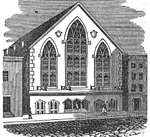Austin and Stone's Dime Museum
19th century in BostonBoston building and structure stubsFormer theatres in BostonGovernment Center, BostonUnited States theatre stubs
Austin and Stone's Dime Museum (ca.1880s-1900s) of Boston, Massachusetts, was an entertainment emporium in Scollay Square (no.4 Tremont Row), established by William Austin and Frank Stone. It featured a freak show as well as dancing girls for entertainment. The freak show and other exhibits such as two-headed animals cost ten cents, while admission to the girlie show cost an additional dime. Performers included William S. Hutchings, the "lightning calculator." Comedian Fred Allen wrote about the Museum in his memoir, Much Ado About Me.
Excerpt from the Wikipedia article Austin and Stone's Dime Museum (License: CC BY-SA 3.0, Authors).Austin and Stone's Dime Museum
Beacon Street, Boston Beacon Hill
Geographical coordinates (GPS) Address Nearby Places Show on map
Geographical coordinates (GPS)
| Latitude | Longitude |
|---|---|
| N 42.3586 ° | E -71.0612 ° |
Address
One Beacon Street
Beacon Street 1
02108 Boston, Beacon Hill
Massachusetts, United States
Open on Google Maps






